Business Structures: Partnership vs. Company (LAWS20059)
VerifiedAdded on 2023/06/10
|13
|3656
|107
Report
AI Summary
This report provides a comprehensive analysis of two common business structures in Australia: partnerships and companies. It begins by defining and comparing the characteristics of each structure, including their setup, liability, and operational aspects. The report then delves into the advantages and disadvantages of each structure, considering factors such as cost, capital raising, taxation, and decision-making processes. It also explores the duties of company directors, using the case of ASIC v Adler as an example to illustrate the responsibilities and potential breaches under the Corporations Act 2001. The report concludes with a recommendation on the most suitable business structure for a given scenario and summarizes the key differences and considerations for selecting between a partnership and a company.

Corporation and Business Structure
Paraphrase This Document
Need a fresh take? Get an instant paraphrase of this document with our AI Paraphraser
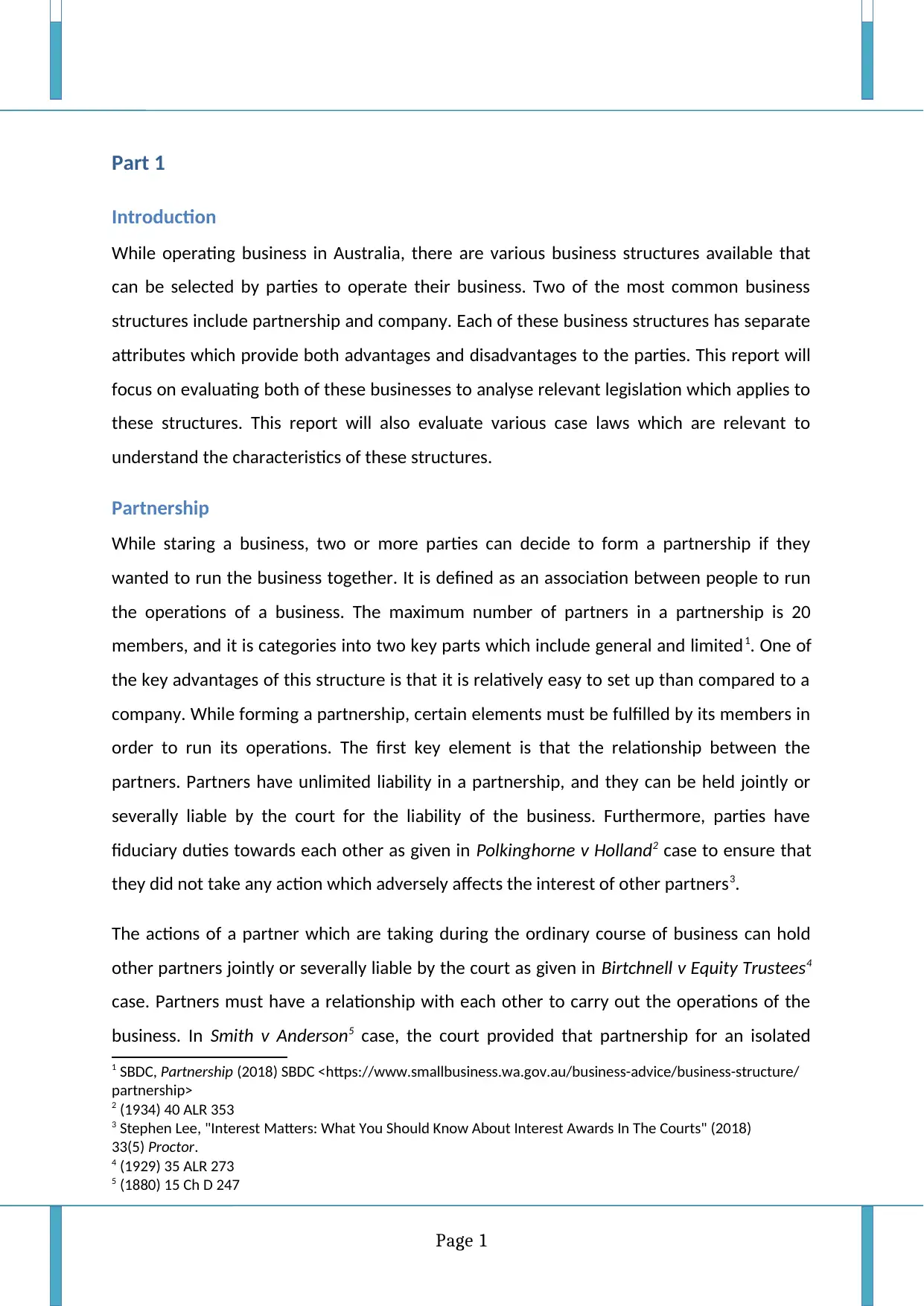
Part 1
Introduction
While operating business in Australia, there are various business structures available that
can be selected by parties to operate their business. Two of the most common business
structures include partnership and company. Each of these business structures has separate
attributes which provide both advantages and disadvantages to the parties. This report will
focus on evaluating both of these businesses to analyse relevant legislation which applies to
these structures. This report will also evaluate various case laws which are relevant to
understand the characteristics of these structures.
Partnership
While staring a business, two or more parties can decide to form a partnership if they
wanted to run the business together. It is defined as an association between people to run
the operations of a business. The maximum number of partners in a partnership is 20
members, and it is categories into two key parts which include general and limited1. One of
the key advantages of this structure is that it is relatively easy to set up than compared to a
company. While forming a partnership, certain elements must be fulfilled by its members in
order to run its operations. The first key element is that the relationship between the
partners. Partners have unlimited liability in a partnership, and they can be held jointly or
severally liable by the court for the liability of the business. Furthermore, parties have
fiduciary duties towards each other as given in Polkinghorne v Holland2 case to ensure that
they did not take any action which adversely affects the interest of other partners3.
The actions of a partner which are taking during the ordinary course of business can hold
other partners jointly or severally liable by the court as given in Birtchnell v Equity Trustees4
case. Partners must have a relationship with each other to carry out the operations of the
business. In Smith v Anderson5 case, the court provided that partnership for an isolated
1 SBDC, Partnership (2018) SBDC <https://www.smallbusiness.wa.gov.au/business-advice/business-structure/
partnership>
2 (1934) 40 ALR 353
3 Stephen Lee, "Interest Matters: What You Should Know About Interest Awards In The Courts" (2018)
33(5) Proctor.
4 (1929) 35 ALR 273
5 (1880) 15 Ch D 247
Page 1
Introduction
While operating business in Australia, there are various business structures available that
can be selected by parties to operate their business. Two of the most common business
structures include partnership and company. Each of these business structures has separate
attributes which provide both advantages and disadvantages to the parties. This report will
focus on evaluating both of these businesses to analyse relevant legislation which applies to
these structures. This report will also evaluate various case laws which are relevant to
understand the characteristics of these structures.
Partnership
While staring a business, two or more parties can decide to form a partnership if they
wanted to run the business together. It is defined as an association between people to run
the operations of a business. The maximum number of partners in a partnership is 20
members, and it is categories into two key parts which include general and limited1. One of
the key advantages of this structure is that it is relatively easy to set up than compared to a
company. While forming a partnership, certain elements must be fulfilled by its members in
order to run its operations. The first key element is that the relationship between the
partners. Partners have unlimited liability in a partnership, and they can be held jointly or
severally liable by the court for the liability of the business. Furthermore, parties have
fiduciary duties towards each other as given in Polkinghorne v Holland2 case to ensure that
they did not take any action which adversely affects the interest of other partners3.
The actions of a partner which are taking during the ordinary course of business can hold
other partners jointly or severally liable by the court as given in Birtchnell v Equity Trustees4
case. Partners must have a relationship with each other to carry out the operations of the
business. In Smith v Anderson5 case, the court provided that partnership for an isolated
1 SBDC, Partnership (2018) SBDC <https://www.smallbusiness.wa.gov.au/business-advice/business-structure/
partnership>
2 (1934) 40 ALR 353
3 Stephen Lee, "Interest Matters: What You Should Know About Interest Awards In The Courts" (2018)
33(5) Proctor.
4 (1929) 35 ALR 273
5 (1880) 15 Ch D 247
Page 1
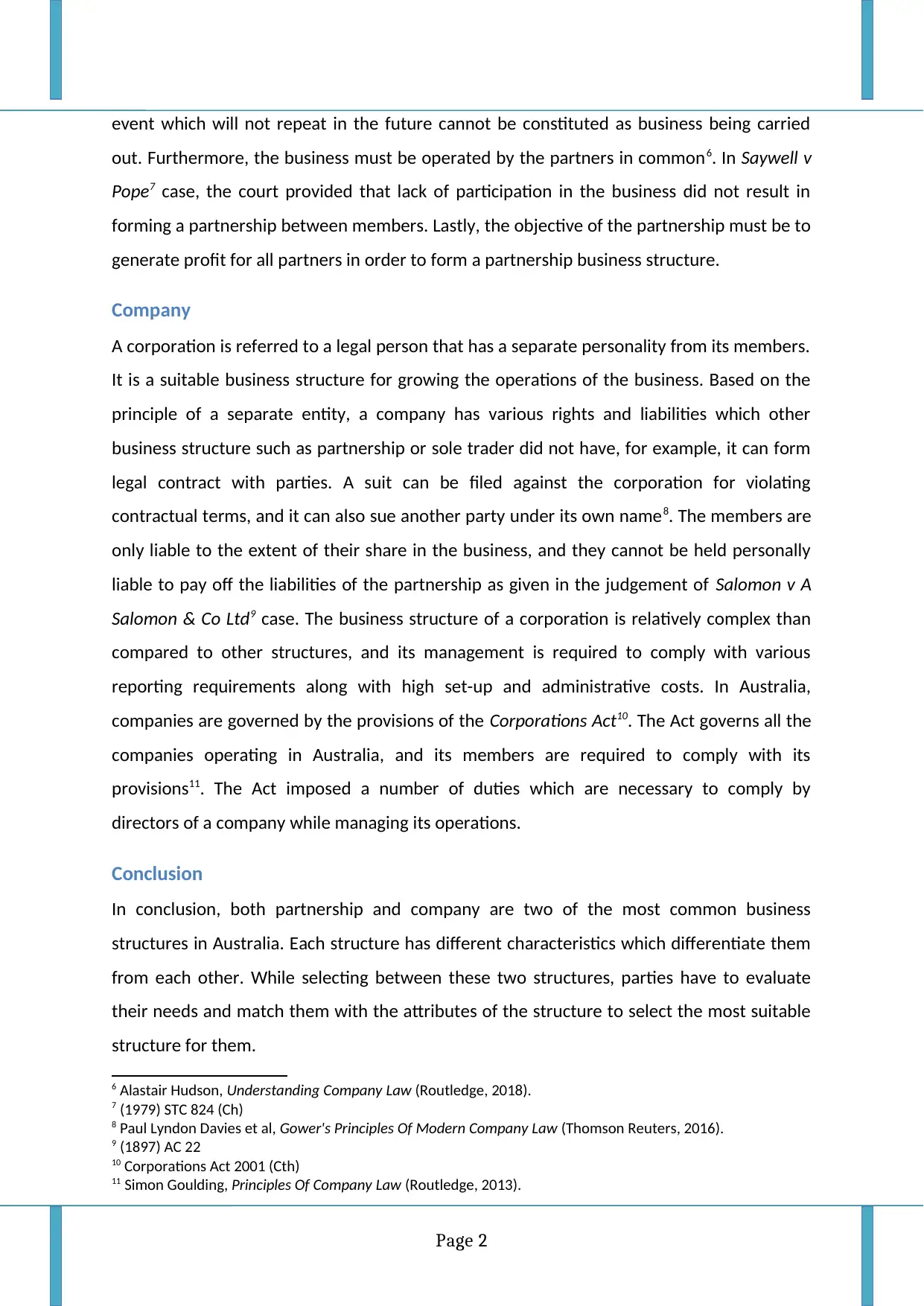
event which will not repeat in the future cannot be constituted as business being carried
out. Furthermore, the business must be operated by the partners in common6. In Saywell v
Pope7 case, the court provided that lack of participation in the business did not result in
forming a partnership between members. Lastly, the objective of the partnership must be to
generate profit for all partners in order to form a partnership business structure.
Company
A corporation is referred to a legal person that has a separate personality from its members.
It is a suitable business structure for growing the operations of the business. Based on the
principle of a separate entity, a company has various rights and liabilities which other
business structure such as partnership or sole trader did not have, for example, it can form
legal contract with parties. A suit can be filed against the corporation for violating
contractual terms, and it can also sue another party under its own name8. The members are
only liable to the extent of their share in the business, and they cannot be held personally
liable to pay off the liabilities of the partnership as given in the judgement of Salomon v A
Salomon & Co Ltd9 case. The business structure of a corporation is relatively complex than
compared to other structures, and its management is required to comply with various
reporting requirements along with high set-up and administrative costs. In Australia,
companies are governed by the provisions of the Corporations Act10. The Act governs all the
companies operating in Australia, and its members are required to comply with its
provisions11. The Act imposed a number of duties which are necessary to comply by
directors of a company while managing its operations.
Conclusion
In conclusion, both partnership and company are two of the most common business
structures in Australia. Each structure has different characteristics which differentiate them
from each other. While selecting between these two structures, parties have to evaluate
their needs and match them with the attributes of the structure to select the most suitable
structure for them.
6 Alastair Hudson, Understanding Company Law (Routledge, 2018).
7 (1979) STC 824 (Ch)
8 Paul Lyndon Davies et al, Gower's Principles Of Modern Company Law (Thomson Reuters, 2016).
9 (1897) AC 22
10 Corporations Act 2001 (Cth)
11 Simon Goulding, Principles Of Company Law (Routledge, 2013).
Page 2
out. Furthermore, the business must be operated by the partners in common6. In Saywell v
Pope7 case, the court provided that lack of participation in the business did not result in
forming a partnership between members. Lastly, the objective of the partnership must be to
generate profit for all partners in order to form a partnership business structure.
Company
A corporation is referred to a legal person that has a separate personality from its members.
It is a suitable business structure for growing the operations of the business. Based on the
principle of a separate entity, a company has various rights and liabilities which other
business structure such as partnership or sole trader did not have, for example, it can form
legal contract with parties. A suit can be filed against the corporation for violating
contractual terms, and it can also sue another party under its own name8. The members are
only liable to the extent of their share in the business, and they cannot be held personally
liable to pay off the liabilities of the partnership as given in the judgement of Salomon v A
Salomon & Co Ltd9 case. The business structure of a corporation is relatively complex than
compared to other structures, and its management is required to comply with various
reporting requirements along with high set-up and administrative costs. In Australia,
companies are governed by the provisions of the Corporations Act10. The Act governs all the
companies operating in Australia, and its members are required to comply with its
provisions11. The Act imposed a number of duties which are necessary to comply by
directors of a company while managing its operations.
Conclusion
In conclusion, both partnership and company are two of the most common business
structures in Australia. Each structure has different characteristics which differentiate them
from each other. While selecting between these two structures, parties have to evaluate
their needs and match them with the attributes of the structure to select the most suitable
structure for them.
6 Alastair Hudson, Understanding Company Law (Routledge, 2018).
7 (1979) STC 824 (Ch)
8 Paul Lyndon Davies et al, Gower's Principles Of Modern Company Law (Thomson Reuters, 2016).
9 (1897) AC 22
10 Corporations Act 2001 (Cth)
11 Simon Goulding, Principles Of Company Law (Routledge, 2013).
Page 2
⊘ This is a preview!⊘
Do you want full access?
Subscribe today to unlock all pages.

Trusted by 1+ million students worldwide

Page 3
Paraphrase This Document
Need a fresh take? Get an instant paraphrase of this document with our AI Paraphraser
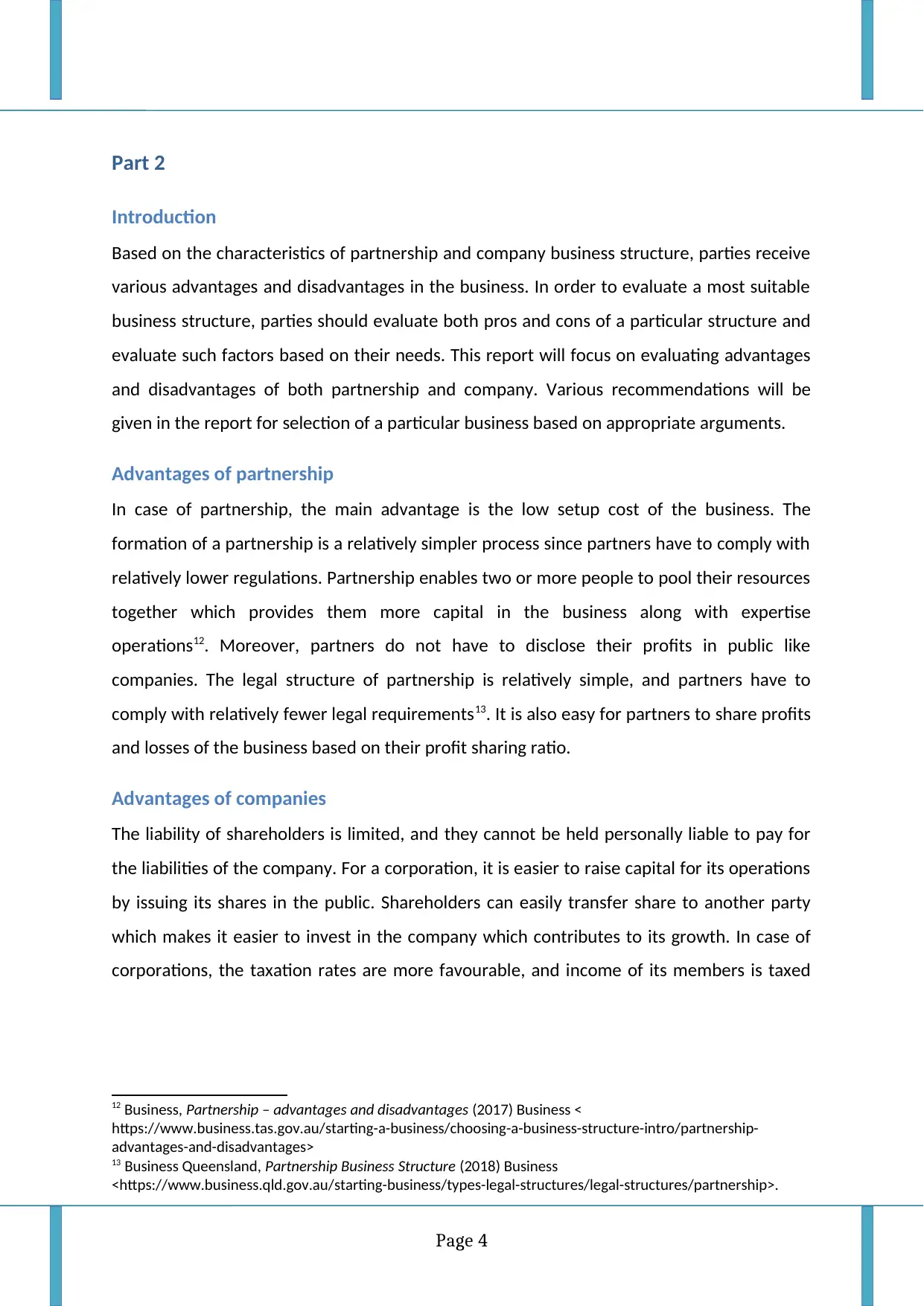
Part 2
Introduction
Based on the characteristics of partnership and company business structure, parties receive
various advantages and disadvantages in the business. In order to evaluate a most suitable
business structure, parties should evaluate both pros and cons of a particular structure and
evaluate such factors based on their needs. This report will focus on evaluating advantages
and disadvantages of both partnership and company. Various recommendations will be
given in the report for selection of a particular business based on appropriate arguments.
Advantages of partnership
In case of partnership, the main advantage is the low setup cost of the business. The
formation of a partnership is a relatively simpler process since partners have to comply with
relatively lower regulations. Partnership enables two or more people to pool their resources
together which provides them more capital in the business along with expertise
operations12. Moreover, partners do not have to disclose their profits in public like
companies. The legal structure of partnership is relatively simple, and partners have to
comply with relatively fewer legal requirements13. It is also easy for partners to share profits
and losses of the business based on their profit sharing ratio.
Advantages of companies
The liability of shareholders is limited, and they cannot be held personally liable to pay for
the liabilities of the company. For a corporation, it is easier to raise capital for its operations
by issuing its shares in the public. Shareholders can easily transfer share to another party
which makes it easier to invest in the company which contributes to its growth. In case of
corporations, the taxation rates are more favourable, and income of its members is taxed
12 Business, Partnership – advantages and disadvantages (2017) Business <
https://www.business.tas.gov.au/starting-a-business/choosing-a-business-structure-intro/partnership-
advantages-and-disadvantages>
13 Business Queensland, Partnership Business Structure (2018) Business
<https://www.business.qld.gov.au/starting-business/types-legal-structures/legal-structures/partnership>.
Page 4
Introduction
Based on the characteristics of partnership and company business structure, parties receive
various advantages and disadvantages in the business. In order to evaluate a most suitable
business structure, parties should evaluate both pros and cons of a particular structure and
evaluate such factors based on their needs. This report will focus on evaluating advantages
and disadvantages of both partnership and company. Various recommendations will be
given in the report for selection of a particular business based on appropriate arguments.
Advantages of partnership
In case of partnership, the main advantage is the low setup cost of the business. The
formation of a partnership is a relatively simpler process since partners have to comply with
relatively lower regulations. Partnership enables two or more people to pool their resources
together which provides them more capital in the business along with expertise
operations12. Moreover, partners do not have to disclose their profits in public like
companies. The legal structure of partnership is relatively simple, and partners have to
comply with relatively fewer legal requirements13. It is also easy for partners to share profits
and losses of the business based on their profit sharing ratio.
Advantages of companies
The liability of shareholders is limited, and they cannot be held personally liable to pay for
the liabilities of the company. For a corporation, it is easier to raise capital for its operations
by issuing its shares in the public. Shareholders can easily transfer share to another party
which makes it easier to invest in the company which contributes to its growth. In case of
corporations, the taxation rates are more favourable, and income of its members is taxed
12 Business, Partnership – advantages and disadvantages (2017) Business <
https://www.business.tas.gov.au/starting-a-business/choosing-a-business-structure-intro/partnership-
advantages-and-disadvantages>
13 Business Queensland, Partnership Business Structure (2018) Business
<https://www.business.qld.gov.au/starting-business/types-legal-structures/legal-structures/partnership>.
Page 4
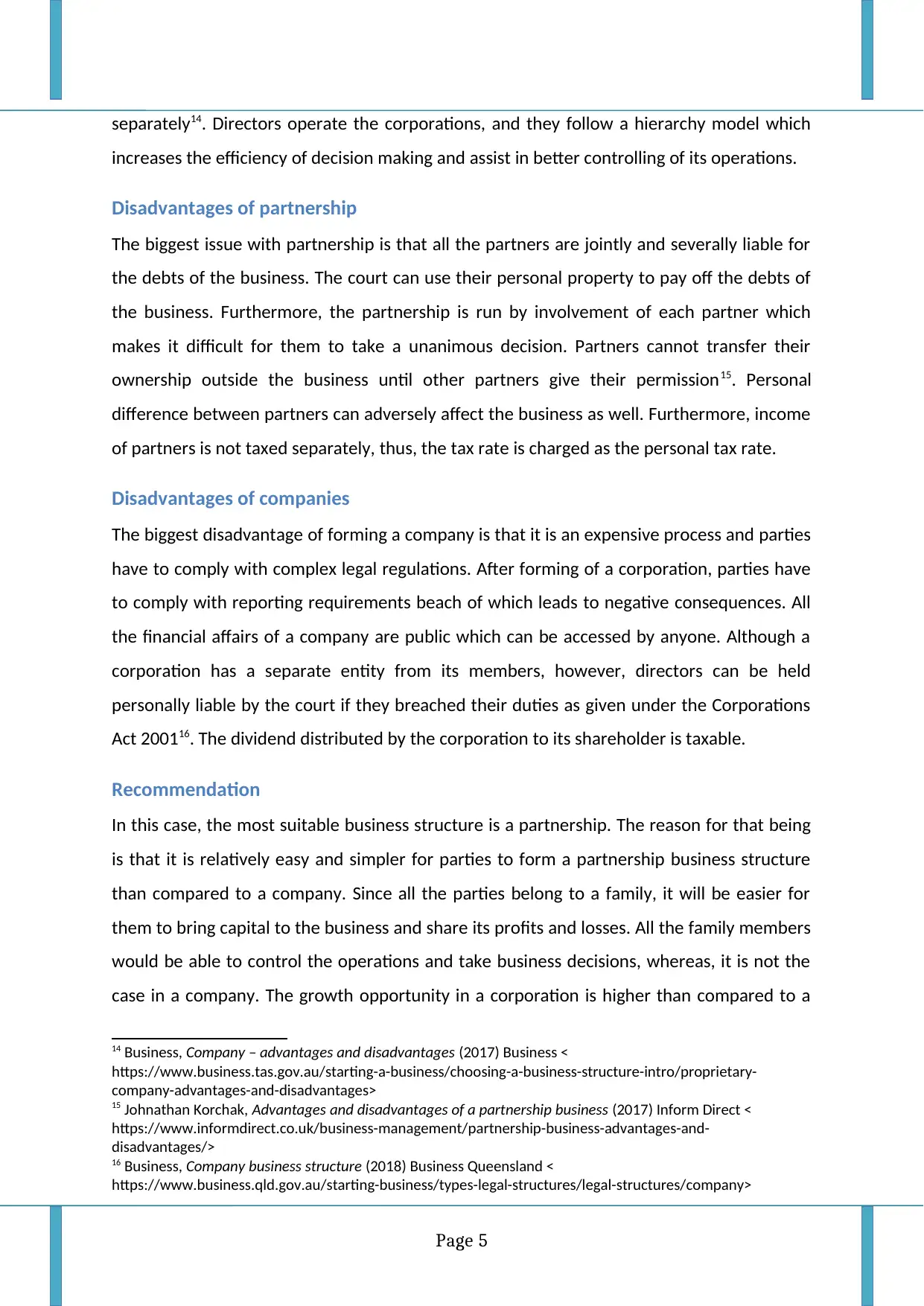
separately14. Directors operate the corporations, and they follow a hierarchy model which
increases the efficiency of decision making and assist in better controlling of its operations.
Disadvantages of partnership
The biggest issue with partnership is that all the partners are jointly and severally liable for
the debts of the business. The court can use their personal property to pay off the debts of
the business. Furthermore, the partnership is run by involvement of each partner which
makes it difficult for them to take a unanimous decision. Partners cannot transfer their
ownership outside the business until other partners give their permission15. Personal
difference between partners can adversely affect the business as well. Furthermore, income
of partners is not taxed separately, thus, the tax rate is charged as the personal tax rate.
Disadvantages of companies
The biggest disadvantage of forming a company is that it is an expensive process and parties
have to comply with complex legal regulations. After forming of a corporation, parties have
to comply with reporting requirements beach of which leads to negative consequences. All
the financial affairs of a company are public which can be accessed by anyone. Although a
corporation has a separate entity from its members, however, directors can be held
personally liable by the court if they breached their duties as given under the Corporations
Act 200116. The dividend distributed by the corporation to its shareholder is taxable.
Recommendation
In this case, the most suitable business structure is a partnership. The reason for that being
is that it is relatively easy and simpler for parties to form a partnership business structure
than compared to a company. Since all the parties belong to a family, it will be easier for
them to bring capital to the business and share its profits and losses. All the family members
would be able to control the operations and take business decisions, whereas, it is not the
case in a company. The growth opportunity in a corporation is higher than compared to a
14 Business, Company – advantages and disadvantages (2017) Business <
https://www.business.tas.gov.au/starting-a-business/choosing-a-business-structure-intro/proprietary-
company-advantages-and-disadvantages>
15 Johnathan Korchak, Advantages and disadvantages of a partnership business (2017) Inform Direct <
https://www.informdirect.co.uk/business-management/partnership-business-advantages-and-
disadvantages/>
16 Business, Company business structure (2018) Business Queensland <
https://www.business.qld.gov.au/starting-business/types-legal-structures/legal-structures/company>
Page 5
increases the efficiency of decision making and assist in better controlling of its operations.
Disadvantages of partnership
The biggest issue with partnership is that all the partners are jointly and severally liable for
the debts of the business. The court can use their personal property to pay off the debts of
the business. Furthermore, the partnership is run by involvement of each partner which
makes it difficult for them to take a unanimous decision. Partners cannot transfer their
ownership outside the business until other partners give their permission15. Personal
difference between partners can adversely affect the business as well. Furthermore, income
of partners is not taxed separately, thus, the tax rate is charged as the personal tax rate.
Disadvantages of companies
The biggest disadvantage of forming a company is that it is an expensive process and parties
have to comply with complex legal regulations. After forming of a corporation, parties have
to comply with reporting requirements beach of which leads to negative consequences. All
the financial affairs of a company are public which can be accessed by anyone. Although a
corporation has a separate entity from its members, however, directors can be held
personally liable by the court if they breached their duties as given under the Corporations
Act 200116. The dividend distributed by the corporation to its shareholder is taxable.
Recommendation
In this case, the most suitable business structure is a partnership. The reason for that being
is that it is relatively easy and simpler for parties to form a partnership business structure
than compared to a company. Since all the parties belong to a family, it will be easier for
them to bring capital to the business and share its profits and losses. All the family members
would be able to control the operations and take business decisions, whereas, it is not the
case in a company. The growth opportunity in a corporation is higher than compared to a
14 Business, Company – advantages and disadvantages (2017) Business <
https://www.business.tas.gov.au/starting-a-business/choosing-a-business-structure-intro/proprietary-
company-advantages-and-disadvantages>
15 Johnathan Korchak, Advantages and disadvantages of a partnership business (2017) Inform Direct <
https://www.informdirect.co.uk/business-management/partnership-business-advantages-and-
disadvantages/>
16 Business, Company business structure (2018) Business Queensland <
https://www.business.qld.gov.au/starting-business/types-legal-structures/legal-structures/company>
Page 5
⊘ This is a preview!⊘
Do you want full access?
Subscribe today to unlock all pages.

Trusted by 1+ million students worldwide

partnership. However, it will be easier for the parties to change their business structure and
form a company in the future once they establish their business in the real estate market.
Conclusion
In conclusion, both partnership and company have different characteristics which provide
advantages and disadvantages to parties. In this case, a partnership business structure is
more suitable than compared to a company since it will be easier to form and parties will
have effective control over it which would benefit them in the long run.
Page 6
form a company in the future once they establish their business in the real estate market.
Conclusion
In conclusion, both partnership and company have different characteristics which provide
advantages and disadvantages to parties. In this case, a partnership business structure is
more suitable than compared to a company since it will be easier to form and parties will
have effective control over it which would benefit them in the long run.
Page 6
Paraphrase This Document
Need a fresh take? Get an instant paraphrase of this document with our AI Paraphraser
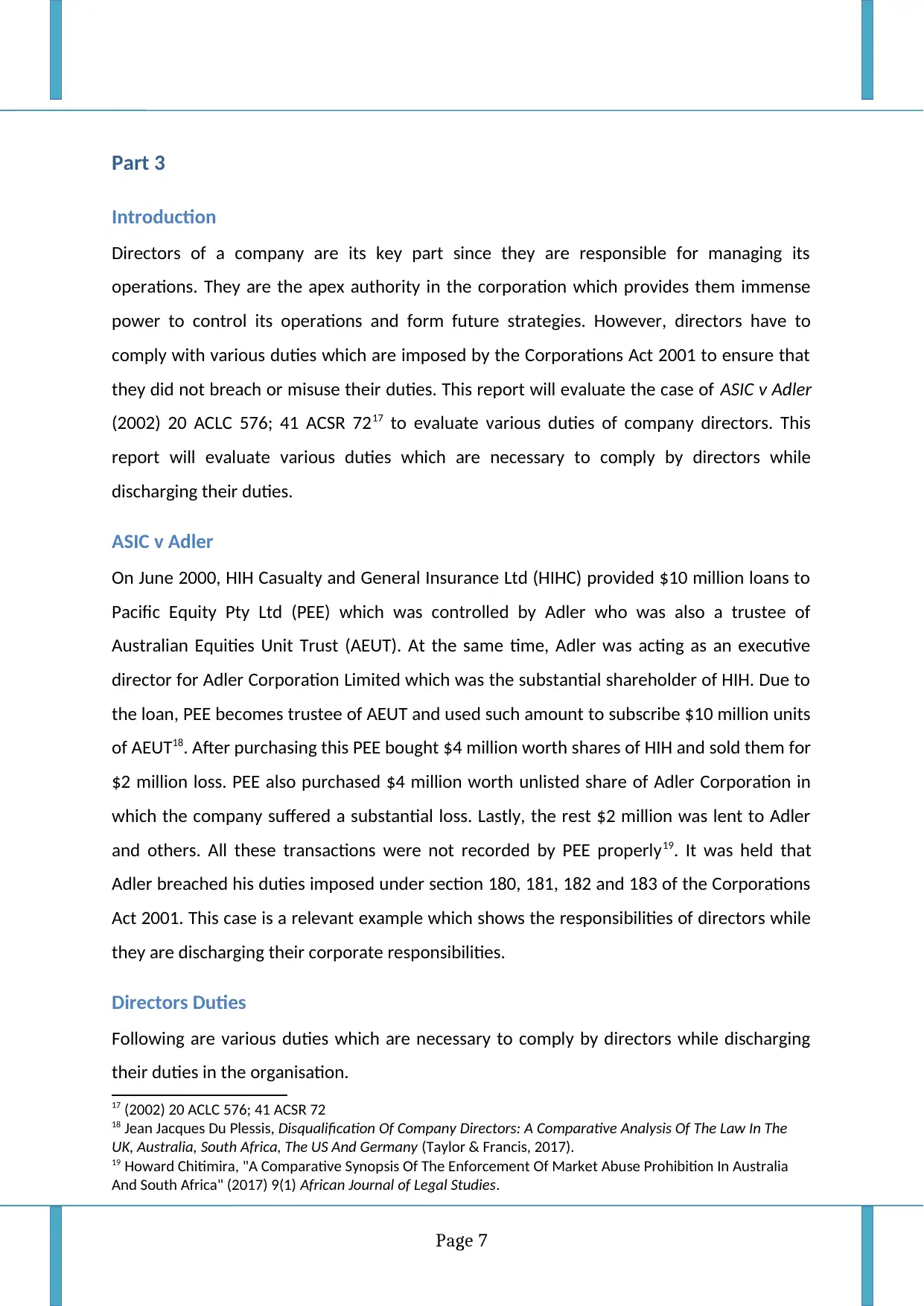
Part 3
Introduction
Directors of a company are its key part since they are responsible for managing its
operations. They are the apex authority in the corporation which provides them immense
power to control its operations and form future strategies. However, directors have to
comply with various duties which are imposed by the Corporations Act 2001 to ensure that
they did not breach or misuse their duties. This report will evaluate the case of ASIC v Adler
(2002) 20 ACLC 576; 41 ACSR 7217 to evaluate various duties of company directors. This
report will evaluate various duties which are necessary to comply by directors while
discharging their duties.
ASIC v Adler
On June 2000, HIH Casualty and General Insurance Ltd (HIHC) provided $10 million loans to
Pacific Equity Pty Ltd (PEE) which was controlled by Adler who was also a trustee of
Australian Equities Unit Trust (AEUT). At the same time, Adler was acting as an executive
director for Adler Corporation Limited which was the substantial shareholder of HIH. Due to
the loan, PEE becomes trustee of AEUT and used such amount to subscribe $10 million units
of AEUT18. After purchasing this PEE bought $4 million worth shares of HIH and sold them for
$2 million loss. PEE also purchased $4 million worth unlisted share of Adler Corporation in
which the company suffered a substantial loss. Lastly, the rest $2 million was lent to Adler
and others. All these transactions were not recorded by PEE properly19. It was held that
Adler breached his duties imposed under section 180, 181, 182 and 183 of the Corporations
Act 2001. This case is a relevant example which shows the responsibilities of directors while
they are discharging their corporate responsibilities.
Directors Duties
Following are various duties which are necessary to comply by directors while discharging
their duties in the organisation.
17 (2002) 20 ACLC 576; 41 ACSR 72
18 Jean Jacques Du Plessis, Disqualification Of Company Directors: A Comparative Analysis Of The Law In The
UK, Australia, South Africa, The US And Germany (Taylor & Francis, 2017).
19 Howard Chitimira, "A Comparative Synopsis Of The Enforcement Of Market Abuse Prohibition In Australia
And South Africa" (2017) 9(1) African Journal of Legal Studies.
Page 7
Introduction
Directors of a company are its key part since they are responsible for managing its
operations. They are the apex authority in the corporation which provides them immense
power to control its operations and form future strategies. However, directors have to
comply with various duties which are imposed by the Corporations Act 2001 to ensure that
they did not breach or misuse their duties. This report will evaluate the case of ASIC v Adler
(2002) 20 ACLC 576; 41 ACSR 7217 to evaluate various duties of company directors. This
report will evaluate various duties which are necessary to comply by directors while
discharging their duties.
ASIC v Adler
On June 2000, HIH Casualty and General Insurance Ltd (HIHC) provided $10 million loans to
Pacific Equity Pty Ltd (PEE) which was controlled by Adler who was also a trustee of
Australian Equities Unit Trust (AEUT). At the same time, Adler was acting as an executive
director for Adler Corporation Limited which was the substantial shareholder of HIH. Due to
the loan, PEE becomes trustee of AEUT and used such amount to subscribe $10 million units
of AEUT18. After purchasing this PEE bought $4 million worth shares of HIH and sold them for
$2 million loss. PEE also purchased $4 million worth unlisted share of Adler Corporation in
which the company suffered a substantial loss. Lastly, the rest $2 million was lent to Adler
and others. All these transactions were not recorded by PEE properly19. It was held that
Adler breached his duties imposed under section 180, 181, 182 and 183 of the Corporations
Act 2001. This case is a relevant example which shows the responsibilities of directors while
they are discharging their corporate responsibilities.
Directors Duties
Following are various duties which are necessary to comply by directors while discharging
their duties in the organisation.
17 (2002) 20 ACLC 576; 41 ACSR 72
18 Jean Jacques Du Plessis, Disqualification Of Company Directors: A Comparative Analysis Of The Law In The
UK, Australia, South Africa, The US And Germany (Taylor & Francis, 2017).
19 Howard Chitimira, "A Comparative Synopsis Of The Enforcement Of Market Abuse Prohibition In Australia
And South Africa" (2017) 9(1) African Journal of Legal Studies.
Page 7
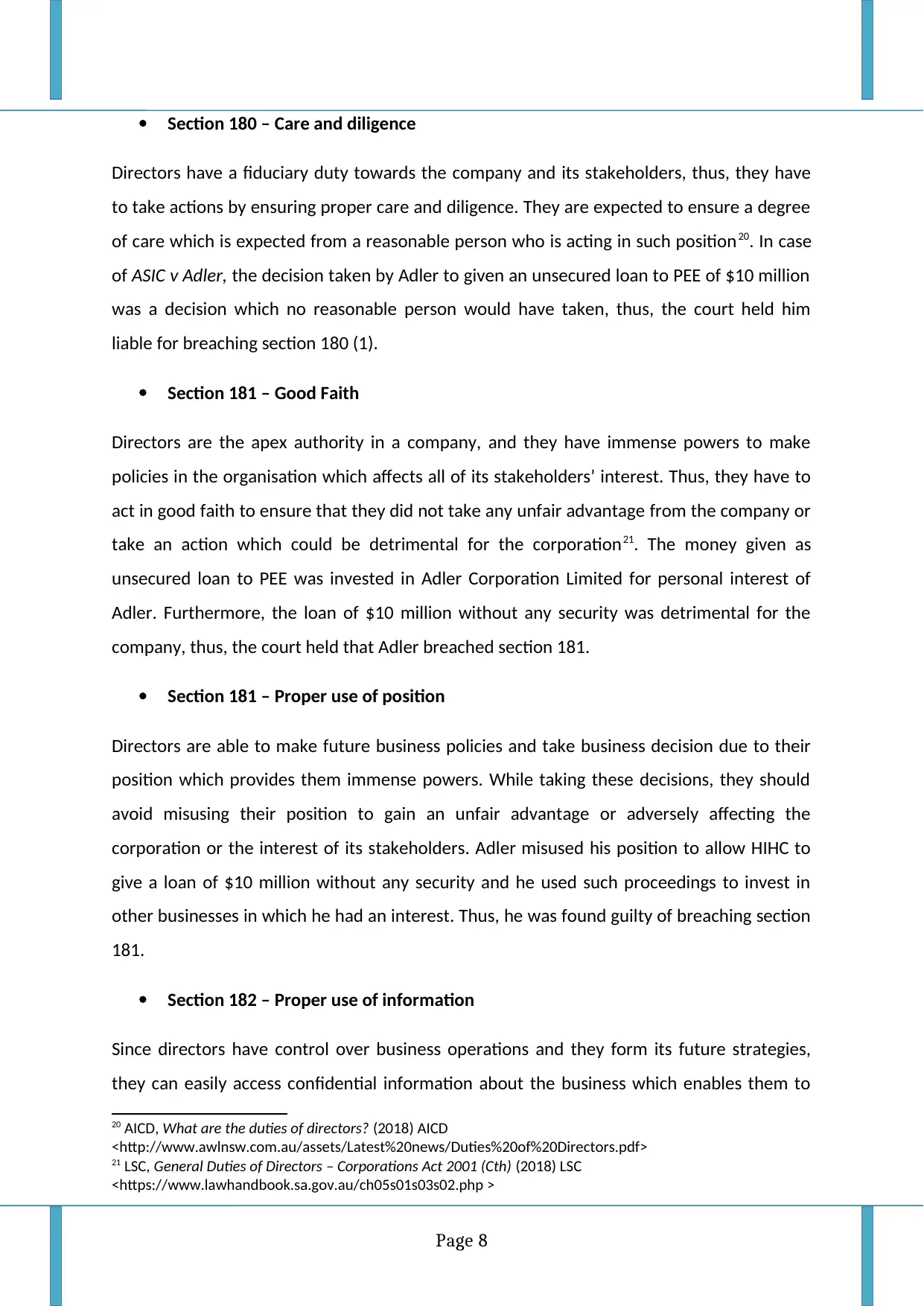
Section 180 – Care and diligence
Directors have a fiduciary duty towards the company and its stakeholders, thus, they have
to take actions by ensuring proper care and diligence. They are expected to ensure a degree
of care which is expected from a reasonable person who is acting in such position20. In case
of ASIC v Adler, the decision taken by Adler to given an unsecured loan to PEE of $10 million
was a decision which no reasonable person would have taken, thus, the court held him
liable for breaching section 180 (1).
Section 181 – Good Faith
Directors are the apex authority in a company, and they have immense powers to make
policies in the organisation which affects all of its stakeholders’ interest. Thus, they have to
act in good faith to ensure that they did not take any unfair advantage from the company or
take an action which could be detrimental for the corporation21. The money given as
unsecured loan to PEE was invested in Adler Corporation Limited for personal interest of
Adler. Furthermore, the loan of $10 million without any security was detrimental for the
company, thus, the court held that Adler breached section 181.
Section 181 – Proper use of position
Directors are able to make future business policies and take business decision due to their
position which provides them immense powers. While taking these decisions, they should
avoid misusing their position to gain an unfair advantage or adversely affecting the
corporation or the interest of its stakeholders. Adler misused his position to allow HIHC to
give a loan of $10 million without any security and he used such proceedings to invest in
other businesses in which he had an interest. Thus, he was found guilty of breaching section
181.
Section 182 – Proper use of information
Since directors have control over business operations and they form its future strategies,
they can easily access confidential information about the business which enables them to
20 AICD, What are the duties of directors? (2018) AICD
<http://www.awlnsw.com.au/assets/Latest%20news/Duties%20of%20Directors.pdf>
21 LSC, General Duties of Directors – Corporations Act 2001 (Cth) (2018) LSC
<https://www.lawhandbook.sa.gov.au/ch05s01s03s02.php >
Page 8
Directors have a fiduciary duty towards the company and its stakeholders, thus, they have
to take actions by ensuring proper care and diligence. They are expected to ensure a degree
of care which is expected from a reasonable person who is acting in such position20. In case
of ASIC v Adler, the decision taken by Adler to given an unsecured loan to PEE of $10 million
was a decision which no reasonable person would have taken, thus, the court held him
liable for breaching section 180 (1).
Section 181 – Good Faith
Directors are the apex authority in a company, and they have immense powers to make
policies in the organisation which affects all of its stakeholders’ interest. Thus, they have to
act in good faith to ensure that they did not take any unfair advantage from the company or
take an action which could be detrimental for the corporation21. The money given as
unsecured loan to PEE was invested in Adler Corporation Limited for personal interest of
Adler. Furthermore, the loan of $10 million without any security was detrimental for the
company, thus, the court held that Adler breached section 181.
Section 181 – Proper use of position
Directors are able to make future business policies and take business decision due to their
position which provides them immense powers. While taking these decisions, they should
avoid misusing their position to gain an unfair advantage or adversely affecting the
corporation or the interest of its stakeholders. Adler misused his position to allow HIHC to
give a loan of $10 million without any security and he used such proceedings to invest in
other businesses in which he had an interest. Thus, he was found guilty of breaching section
181.
Section 182 – Proper use of information
Since directors have control over business operations and they form its future strategies,
they can easily access confidential information about the business which enables them to
20 AICD, What are the duties of directors? (2018) AICD
<http://www.awlnsw.com.au/assets/Latest%20news/Duties%20of%20Directors.pdf>
21 LSC, General Duties of Directors – Corporations Act 2001 (Cth) (2018) LSC
<https://www.lawhandbook.sa.gov.au/ch05s01s03s02.php >
Page 8
⊘ This is a preview!⊘
Do you want full access?
Subscribe today to unlock all pages.

Trusted by 1+ million students worldwide

use it for personal advantage. Adler purchased the share of HIH for personal gain based on
which he breached his duties given under section 182.
Conclusion
In conclusion, ASIC v Adler is a relevant case to understand the role of directors’ duties and
their responsibilities in the corporation. While controlling the business operations and
forming future strategies, directors should comply with these duties to avoid taking unfair
advantage of their position and information which could result in adversely affecting the
interest of the company and its stakeholders.
Page 9
which he breached his duties given under section 182.
Conclusion
In conclusion, ASIC v Adler is a relevant case to understand the role of directors’ duties and
their responsibilities in the corporation. While controlling the business operations and
forming future strategies, directors should comply with these duties to avoid taking unfair
advantage of their position and information which could result in adversely affecting the
interest of the company and its stakeholders.
Page 9
Paraphrase This Document
Need a fresh take? Get an instant paraphrase of this document with our AI Paraphraser
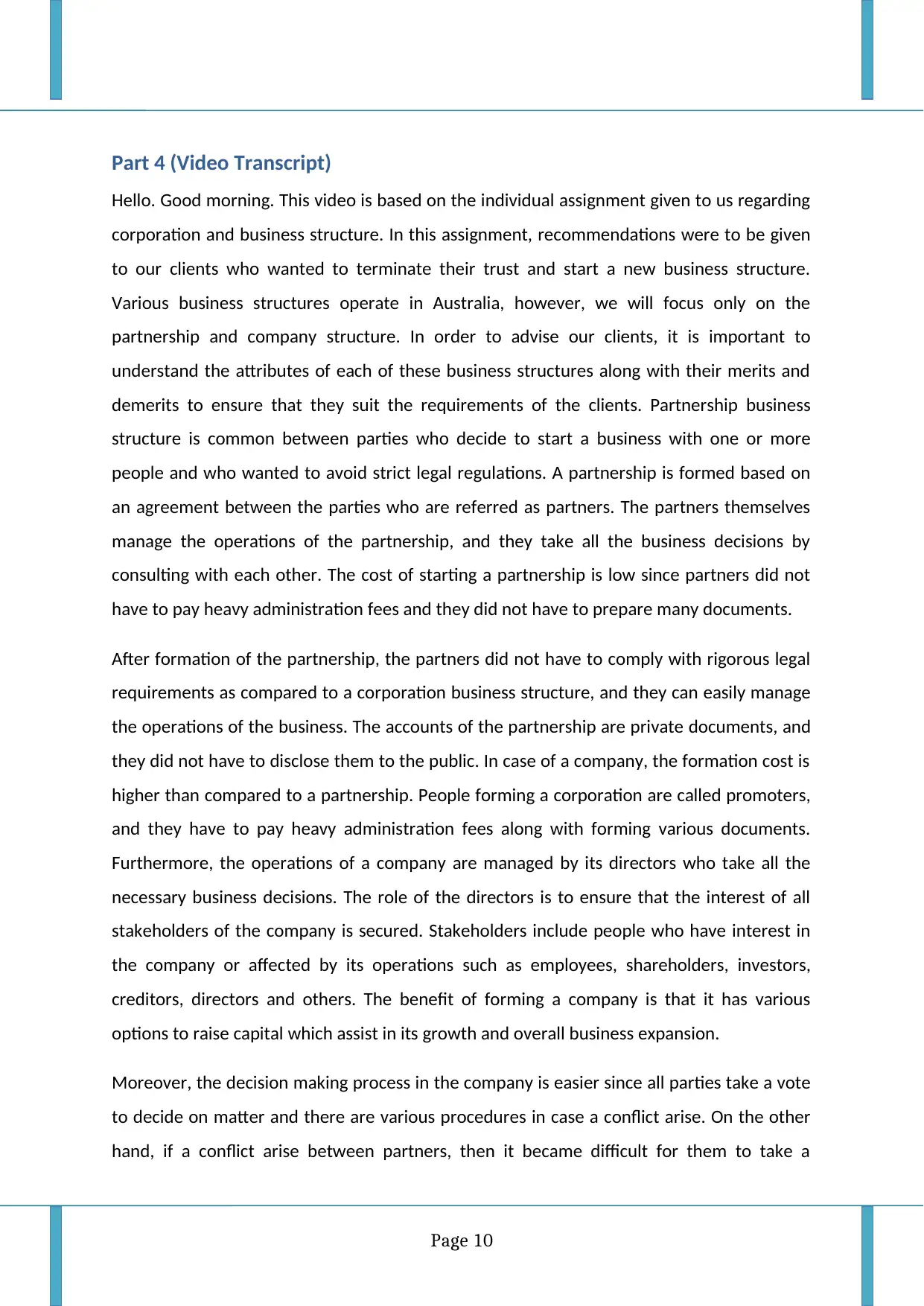
Part 4 (Video Transcript)
Hello. Good morning. This video is based on the individual assignment given to us regarding
corporation and business structure. In this assignment, recommendations were to be given
to our clients who wanted to terminate their trust and start a new business structure.
Various business structures operate in Australia, however, we will focus only on the
partnership and company structure. In order to advise our clients, it is important to
understand the attributes of each of these business structures along with their merits and
demerits to ensure that they suit the requirements of the clients. Partnership business
structure is common between parties who decide to start a business with one or more
people and who wanted to avoid strict legal regulations. A partnership is formed based on
an agreement between the parties who are referred as partners. The partners themselves
manage the operations of the partnership, and they take all the business decisions by
consulting with each other. The cost of starting a partnership is low since partners did not
have to pay heavy administration fees and they did not have to prepare many documents.
After formation of the partnership, the partners did not have to comply with rigorous legal
requirements as compared to a corporation business structure, and they can easily manage
the operations of the business. The accounts of the partnership are private documents, and
they did not have to disclose them to the public. In case of a company, the formation cost is
higher than compared to a partnership. People forming a corporation are called promoters,
and they have to pay heavy administration fees along with forming various documents.
Furthermore, the operations of a company are managed by its directors who take all the
necessary business decisions. The role of the directors is to ensure that the interest of all
stakeholders of the company is secured. Stakeholders include people who have interest in
the company or affected by its operations such as employees, shareholders, investors,
creditors, directors and others. The benefit of forming a company is that it has various
options to raise capital which assist in its growth and overall business expansion.
Moreover, the decision making process in the company is easier since all parties take a vote
to decide on matter and there are various procedures in case a conflict arise. On the other
hand, if a conflict arise between partners, then it became difficult for them to take a
Page 10
Hello. Good morning. This video is based on the individual assignment given to us regarding
corporation and business structure. In this assignment, recommendations were to be given
to our clients who wanted to terminate their trust and start a new business structure.
Various business structures operate in Australia, however, we will focus only on the
partnership and company structure. In order to advise our clients, it is important to
understand the attributes of each of these business structures along with their merits and
demerits to ensure that they suit the requirements of the clients. Partnership business
structure is common between parties who decide to start a business with one or more
people and who wanted to avoid strict legal regulations. A partnership is formed based on
an agreement between the parties who are referred as partners. The partners themselves
manage the operations of the partnership, and they take all the business decisions by
consulting with each other. The cost of starting a partnership is low since partners did not
have to pay heavy administration fees and they did not have to prepare many documents.
After formation of the partnership, the partners did not have to comply with rigorous legal
requirements as compared to a corporation business structure, and they can easily manage
the operations of the business. The accounts of the partnership are private documents, and
they did not have to disclose them to the public. In case of a company, the formation cost is
higher than compared to a partnership. People forming a corporation are called promoters,
and they have to pay heavy administration fees along with forming various documents.
Furthermore, the operations of a company are managed by its directors who take all the
necessary business decisions. The role of the directors is to ensure that the interest of all
stakeholders of the company is secured. Stakeholders include people who have interest in
the company or affected by its operations such as employees, shareholders, investors,
creditors, directors and others. The benefit of forming a company is that it has various
options to raise capital which assist in its growth and overall business expansion.
Moreover, the decision making process in the company is easier since all parties take a vote
to decide on matter and there are various procedures in case a conflict arise. On the other
hand, if a conflict arise between partners, then it became difficult for them to take a
Page 10
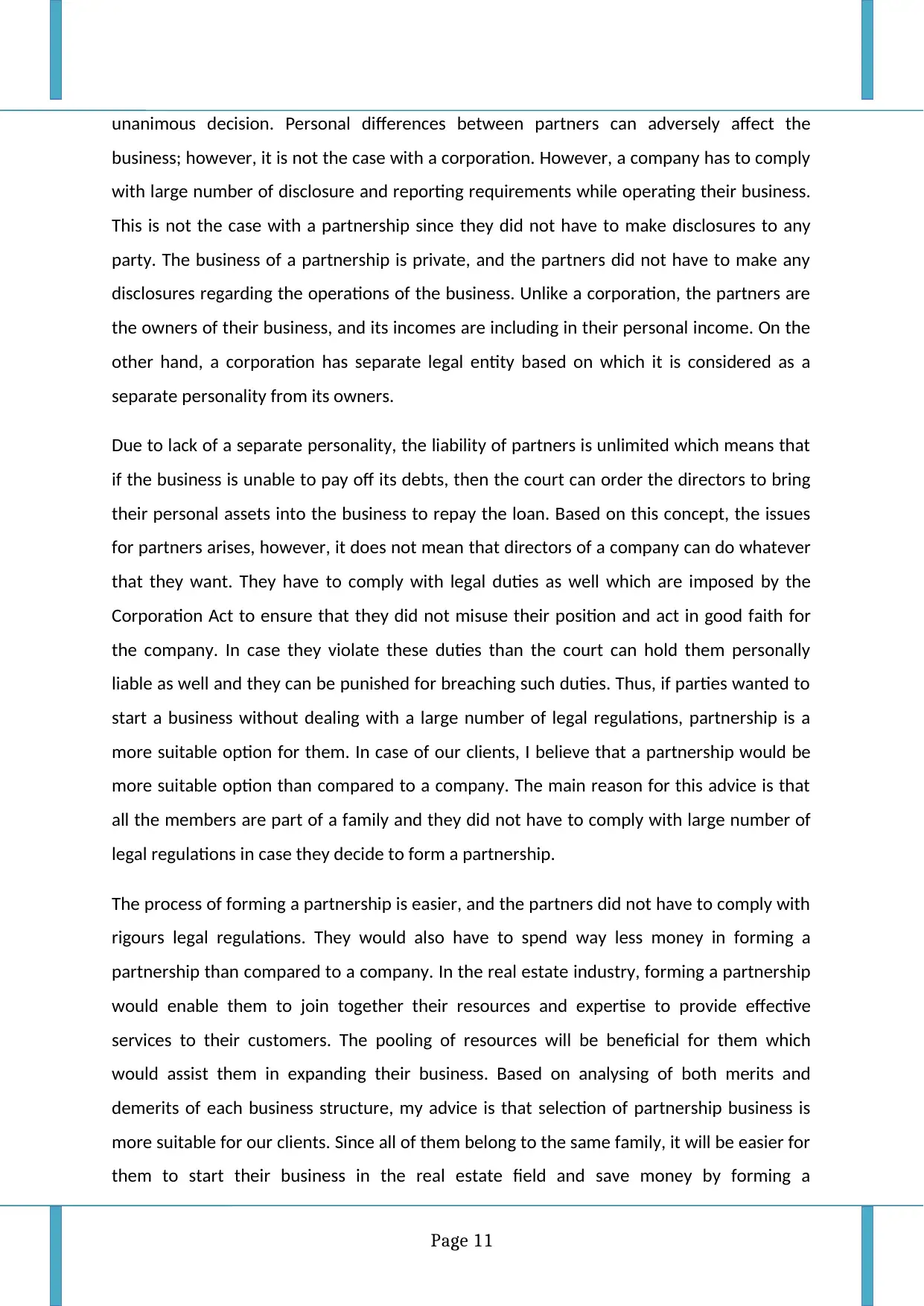
unanimous decision. Personal differences between partners can adversely affect the
business; however, it is not the case with a corporation. However, a company has to comply
with large number of disclosure and reporting requirements while operating their business.
This is not the case with a partnership since they did not have to make disclosures to any
party. The business of a partnership is private, and the partners did not have to make any
disclosures regarding the operations of the business. Unlike a corporation, the partners are
the owners of their business, and its incomes are including in their personal income. On the
other hand, a corporation has separate legal entity based on which it is considered as a
separate personality from its owners.
Due to lack of a separate personality, the liability of partners is unlimited which means that
if the business is unable to pay off its debts, then the court can order the directors to bring
their personal assets into the business to repay the loan. Based on this concept, the issues
for partners arises, however, it does not mean that directors of a company can do whatever
that they want. They have to comply with legal duties as well which are imposed by the
Corporation Act to ensure that they did not misuse their position and act in good faith for
the company. In case they violate these duties than the court can hold them personally
liable as well and they can be punished for breaching such duties. Thus, if parties wanted to
start a business without dealing with a large number of legal regulations, partnership is a
more suitable option for them. In case of our clients, I believe that a partnership would be
more suitable option than compared to a company. The main reason for this advice is that
all the members are part of a family and they did not have to comply with large number of
legal regulations in case they decide to form a partnership.
The process of forming a partnership is easier, and the partners did not have to comply with
rigours legal regulations. They would also have to spend way less money in forming a
partnership than compared to a company. In the real estate industry, forming a partnership
would enable them to join together their resources and expertise to provide effective
services to their customers. The pooling of resources will be beneficial for them which
would assist them in expanding their business. Based on analysing of both merits and
demerits of each business structure, my advice is that selection of partnership business is
more suitable for our clients. Since all of them belong to the same family, it will be easier for
them to start their business in the real estate field and save money by forming a
Page 11
business; however, it is not the case with a corporation. However, a company has to comply
with large number of disclosure and reporting requirements while operating their business.
This is not the case with a partnership since they did not have to make disclosures to any
party. The business of a partnership is private, and the partners did not have to make any
disclosures regarding the operations of the business. Unlike a corporation, the partners are
the owners of their business, and its incomes are including in their personal income. On the
other hand, a corporation has separate legal entity based on which it is considered as a
separate personality from its owners.
Due to lack of a separate personality, the liability of partners is unlimited which means that
if the business is unable to pay off its debts, then the court can order the directors to bring
their personal assets into the business to repay the loan. Based on this concept, the issues
for partners arises, however, it does not mean that directors of a company can do whatever
that they want. They have to comply with legal duties as well which are imposed by the
Corporation Act to ensure that they did not misuse their position and act in good faith for
the company. In case they violate these duties than the court can hold them personally
liable as well and they can be punished for breaching such duties. Thus, if parties wanted to
start a business without dealing with a large number of legal regulations, partnership is a
more suitable option for them. In case of our clients, I believe that a partnership would be
more suitable option than compared to a company. The main reason for this advice is that
all the members are part of a family and they did not have to comply with large number of
legal regulations in case they decide to form a partnership.
The process of forming a partnership is easier, and the partners did not have to comply with
rigours legal regulations. They would also have to spend way less money in forming a
partnership than compared to a company. In the real estate industry, forming a partnership
would enable them to join together their resources and expertise to provide effective
services to their customers. The pooling of resources will be beneficial for them which
would assist them in expanding their business. Based on analysing of both merits and
demerits of each business structure, my advice is that selection of partnership business is
more suitable for our clients. Since all of them belong to the same family, it will be easier for
them to start their business in the real estate field and save money by forming a
Page 11
⊘ This is a preview!⊘
Do you want full access?
Subscribe today to unlock all pages.

Trusted by 1+ million students worldwide
1 out of 13
Related Documents
Your All-in-One AI-Powered Toolkit for Academic Success.
+13062052269
info@desklib.com
Available 24*7 on WhatsApp / Email
![[object Object]](/_next/static/media/star-bottom.7253800d.svg)
Unlock your academic potential
Copyright © 2020–2025 A2Z Services. All Rights Reserved. Developed and managed by ZUCOL.


